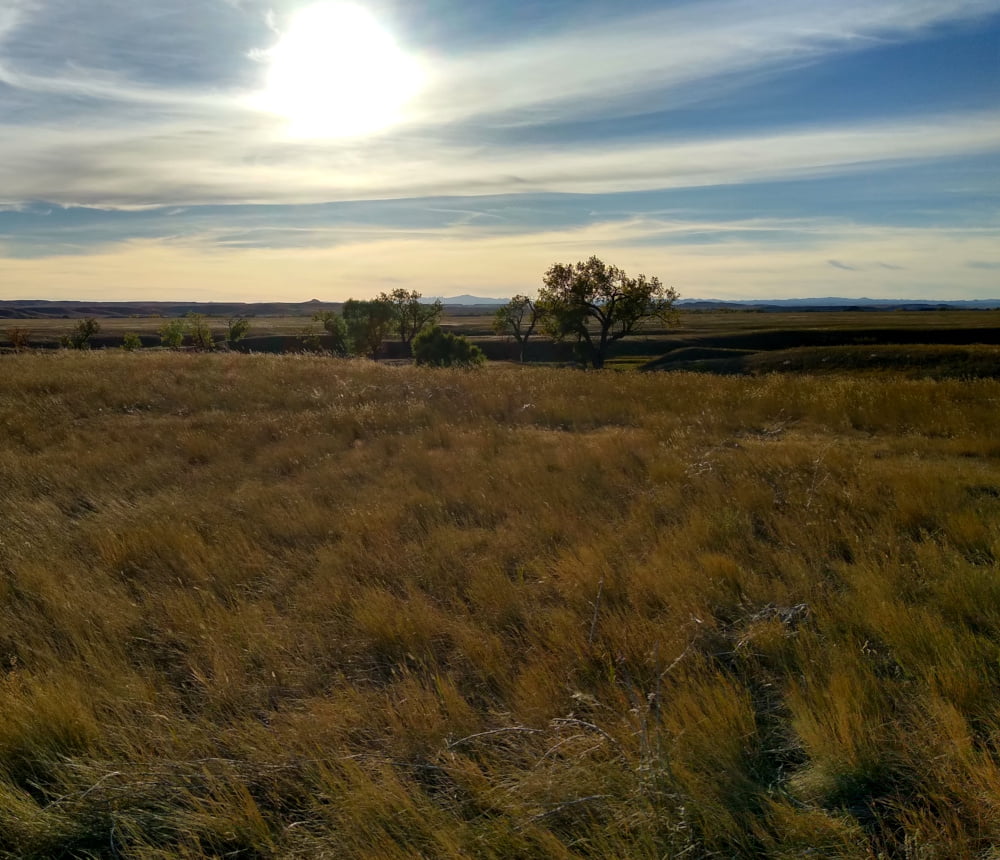I wrote this BriRant as the prairie wind blasted our travel trailer while we camped one evening on our return from the Great Plains to the Great Northwest Woods during our road trip last Autumn. Our time in the Dakotas affected my spirit deeply. History teaches that I am certainly not alone in feeling a deep, mysterious affinity for these great grasslands. I was profoundly struck by the sharp contrast between the diametrically opposed outlooks of two great cultures who collided violently in these lands for the last several centuries. Ghosts are everywhere in this country. The wounds from that violent clash remain unhealed, and perhaps unhealable. This text didn’t seem quite appropriate for the road trip travelogue. But perhaps it’s worthwhile sharing as a BriRant.

As I write, the forbidding northwest wind that began the evening we camped on the bank of the Missouri River in Nebraska before heading westward into the Dakotas continues to beat on the trailer, seemingly trying to drive us off the northern plains. Having recrossed the Missouri at sunset, soon we will be heading northeastward across the prairies of North Dakota and western Minnesota back to the less forbidding woodlands east of the Mississippi. But first, we will pay one last homage to the people who do rightly call this place their home. Just across the river from the town of Mobridge where we camped this evening are monuments to Lewis and Clark’s native guide Sacagawea and the great Lakota Chief Sitting Bull. Perhaps no two people better represent the tragic conflict between the native people belonging to this land and the European invaders who subdued the people and continue to struggle to subdue the land. Sacagawea symbolizes the welcome of the small Corps of Discovery who became the vanguard of a vast wave of domination, exploitation, and annihilation. Sitting Bull – with the victory against Custer and the 7th Cavalry at Little Bighorn – came to symbolize the doomed native resistance to the overwhelming flood of American expansion into his great plains. There is an open controversy about where and when Sacagawea died. She was born hundreds of miles west of here and subsequently sold into slavery as the wife of a French-Canadian trapper with whom she accompanied the Corps of Discovery when she was about 16 years old. After the expedition, she came to live with her husband about 20 miles north of here, and is thought to have died at the age of about 25 in Kenel, SD a few miles upstream across the Missouri River from where her monument now stands. Another account is that she returned to her people and died at an old age in Wyoming. Regardless of which is true, it is appropriate that a monument to her stands on the bluff above the river upon which the Corps of Discovery made its way west by her guidance and aid. Sitting Bull was born very near what is now the town of Mobridge, SD. Of course, the great victory at Little Big Horn – far from driving the white invaders from the land – only solidified their resolve to subdue the plains peoples or wipe them out entirely. The great chief Sitting Bull surrendered the few remaining of his people just five years later. After a brief stint as a performer in Buffalo Bill’s Wild West Show, Sitting Bull returned to the Standing Rock reservation. He was shot dead less than ten years later by two of his own people acting as policemen for the Standing Rock Agency. He had refused to accompany them when they came to arrest him during the tragic year of the Ghost Dance which culminated in the horrifying massacre at Wounded Knee which we came to South Dakota to visit but couldn't due to the COVID-19 pandemic. As with Sacagawea, there is a dispute about the current location of his remains. In 1953, some of his descendants claim to have stolen his body from its original burial place in Ft. Yates, ND where he was killed to the location of the monument to him in Mobridge, SD near the place of his birth. Ironically, even the monuments to these two luminary Native Americans are symbolic of the tragic struggle in which they played such vital parts – a conflict buried just beneath the surface of Dakotan society in a shallow grave which occasionally emits a foul reek. Nowhere is that conflict more evident than at Mt. Rushmore in the Black Hills of far western South Dakota. Every year, thousands of outsiders like Sue and I flock there to see a magnificent memorial to four great leaders of the very people who drove the area’s original and rightful occupants from the land they consider sacred – the Black Hills into which these magnificent heads are carved. As I got into position to take Sue’s photo in front of these giant faces, I took my sunglasses off so I could see the display on my smartphone camera without having to tilt my head. I callously remarked to Sue, “Better take off these polarized lenses, because after all there’s nothing in America quite so polarizing as Mt. Rushmore.” Since the doggies weren’t allowed in the sculpture observation area, we stayed only briefly at Mt. Rushmore, and drove away seeking a place to enjoy the natural beauty of the Black Hills. Even the little Horsethief Lake where we took a short hike is an example of the white man’s domination of the land. It is very beautiful, but it is an artificial lake put there by the CCC while the carvings on Mt. Rushmore were taking place a few miles away. The lake serves no real practical purpose, but was built just to appeal to the aesthetic tastes of the invaders of the land. The Lakota people consider the hills sacred and inviolable which is why the existence of the Mt. Rushmore Memorial is so prickling to them. Like all of the Dakotas, the Black Hills are a land of sharp contrast. After our leisurely stroll around the beautiful Horsethief Lake, we continued through the hills making our way north through the dismal tourist traps of Hill City and Deadwood. Here we found every conceivable example of tasteless exploitation of the hills. Tragically (or perhaps thankfully), many of these blights on the land are empty and lifeless due to the COVID-19 pandemic, and many of the businesses there are apparently shuttered for good. As we made our way north out of the hills back into the blaring wind on the open plain, it occurred to me that the native people worship the Black Hills themselves for the sake of their beauty, while the white usurpers worship at the altar of greed and exploitation seeking to take from the hills whatever monetary gains they may. Few are those of us who worship neither the creation nor the pleasures of this world, but rather the great Creator who made them so that we might all in turn use His gifts to serve and edify one another. That is the real tragedy of the Dakotas.

